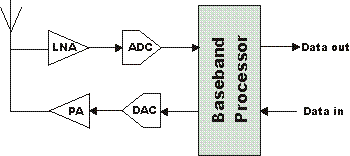Software Defined Radio, SDR Hardware
The software defined radio hardware architecture needs to be carefully understood and designed to ensure that the optimum performance is gained.
Home » Radio & RF technology » this page
Software Defined Radio Includes:
SDR basics
SDR hardware architecture
How to buy the best SDR
The hardware for a software defined radio is a particularly important element of the overall design. While the whole idea of the radio is that it is fundamentally driven by software, it still needs the basic hardware to enable the software to run.
the software defined radio hardware presents some interesting challenges to the hardware development engineer. The performance of the hardware will define exactly how much can be done within the software.
With the interface between software and hardware controlled functions needing to be as close to the antenna as possible to provide greater levels of software control and hence reconfigurability, this provides greater challenges in terms of design, performance and cost. As a result, decisions need to be made at the earliest stages of any design to determine where the boundary will be, based on functionality required, performance and cost.
SDR hardware architecture
Although there are many different levels of SDR and many ways in which a software defined radio may be designed, it possible to give some generalised comments about the basic structures that are used.

Note: No frequency conversion is used in this configuration as the A2D and D2A conversion takes place at the frequency of operation
Apart from the control and management software and its associated hardware, a software defined radio (SDR) can be considered to contain a number of basic functional blocks as detailed below:
- RF Amplification: These elements are the RF amplification of the signals travelling to and from the antenna. On the transmit side the amplifier is used to increase the level of the RF signal to the required power to be transmitted. It is unlikely that direct conversion by the DAC will give the required output level. On the receive side signals from the antenna need to be amplified before passing further into the receiver. If antenna signals are directly converted into digital signals, quantisation noise becomes an issue even f the frequency limits are not exceeded.
- Frequency conversion: In many designs, some analogue processing may be required. Typically this may involve converting the signal to and from the final radio frequency. In some designs this analogue section may not be present and the signal will be converted directly to and from the final frequency from and to the digital format. Some intermediate frequency processing may also be present.
- Digital conversion: It is at this stage that the signal is converted between the digital and analogue formats. This conversion is in many ways at the heart of the equipment.
When undertaking these conversions there are issues that need to be considered. On the receive side, the maximum frequency and number of bits to give the required quantisation noise are of great importance. On the transmit side, the maximum frequency and the required power level are some of the major issues. - Baseband processor: The baseband processor is at the very centre of the software defined radio. It performs many functions from digitally converting the incoming or outgoing signal in frequency. These elements are known as the Digital Up Converter (DUC) for converting the outgoing signal from the base frequency up to the required output frequency for conversion from digital to analogue. On the receive side a Digital Down Converter (DDC) is used to bring the signal down in frequency. The signal also needs to be filtered, demodulated and the required data extracted for further processing.
One of the key issues of the baseband processor is the amount of processing power required. The greater the level of processing, the higher the current consumption and in turn this required additional cooling, etc. This may have an impact on what can be achieved if power consumption and size are limitations. Also the format of any processing needs to be considered - general processors, DSPs, ASICs and in particular FPGAs may be used. FPGAs are of particular interest because they may be reconfigured to change the definition of the radio.
 Written by Ian Poole .
Written by Ian Poole .
Experienced electronics engineer and author.
More Essential Radio Topics:
Radio Signals
Modulation types & techniques
Amplitude modulation
Frequency modulation
OFDM
RF mixing
Phase locked loops
Frequency synthesizers
Passive intermodulation
RF attenuators
RF filters
RF circulator
Radio receiver types
Superhet radio
Receiver selectivity
Receiver sensitivity
Receiver strong signal handling
Receiver dynamic range
Return to Radio topics menu . . .


